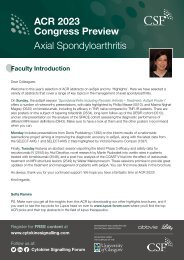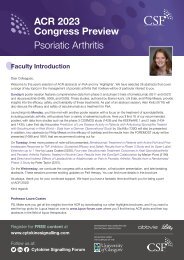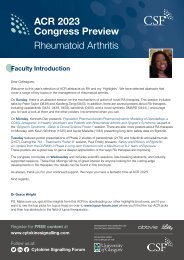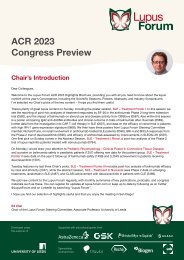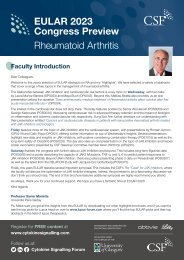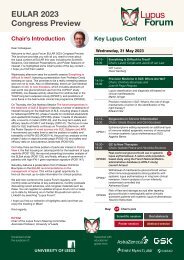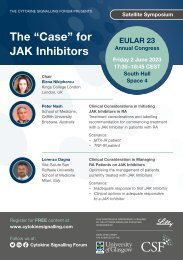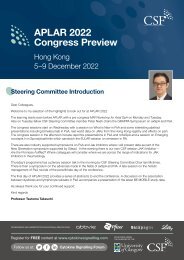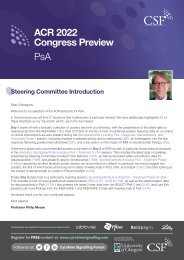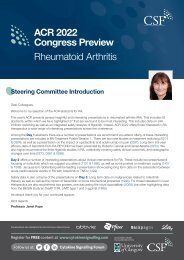EULAR 2018 Review
You also want an ePaper? Increase the reach of your titles
YUMPU automatically turns print PDFs into web optimized ePapers that Google loves.
Baricitinib dose step-down following sustained disease control<br />
The effects of baricitinib dose step-down in patients with RA who achieved sustained<br />
disease control with baricitinib 4 mg were presented by Takeuchi, et al. Patients who<br />
participated in the baricitinib Phase 3 LTE study and received baricitinib 4 mg for ≥15<br />
months, and achieved LDA or remission, were re-randomised to continue baricitinib 4 mg<br />
(n=374) or step-down to baricitinib 2 mg (n=376); patients could rescue to 4 mg. Most<br />
patients in both groups maintained LDA or remission over the 48 weeks; however, dose<br />
reduction to 2 mg resulted in significant increases in disease activity at 12, 24 and 48<br />
weeks, and a shorter time to relapse compared with the 4-mg group. Rates of SAEs and<br />
AEs leading to discontinuation were similar between groups; however, dose reduction was<br />
associated with a lower rate of serious infections. Most rescued patients were able to<br />
regain LDA or remission [#0253].<br />
Baricitinib: HBV reactivation and autoantibody profiling<br />
Harigai and colleagues presented the findings of a post hoc analysis examining hepatitis B<br />
virus (HBV) reactivation in patients with RA who participated in 4 Phase 3 trials of<br />
baricitinib. In a total of 2890 patients who received 1 or more dose of baricitinib (6993<br />
patient-years exposure), 269 patients had baseline serology suggestive of prior infection<br />
and post-baseline HBV DNA tests were performed in 290 patients. Approximately 12% of<br />
baricitinib-treated patients with prior HBV infection later tested positive for HBV DNA (3%<br />
were above the lower limit of detection); no patients developed clinical evidence of<br />
hepatitis, and antiviral therapy was not commonly required [#0077].<br />
An exploratory analysis of autoantibody profiles for response to baricitinib in patients with<br />
RA and no or limited exposure to MTX was presented by Martinez-Gamboa, et al. Baseline<br />
sera samples from patients participating in the Phase 3 trial RA-BEGIN were investigated<br />
for auto-antibody class reactivity towards vimentin (V), modified by citrullation (MCV),<br />
carbamylation (Carb) or acetylation. Seropositive patients with high titres of anti-MCV and<br />
anti-CarbV at baseline showed better responses to baricitinib monotherapy or baricitinib<br />
plus MTX for composite scores, and better response to baricitinib monotherapy in<br />
structural progression outcomes [#0109]<br />
Patient-reported outcomes with baricitinib<br />
Bingham and colleagues reported an analysis of PROs from the Phase 3 RA-BEAM and<br />
RA-BEACON trials of baricitinib in patients with RA with an inadequate response to MTX.<br />
FACIT-F and SF-36 BP scores were converted to Patient-Reported Outcomes<br />
Measurement Information System (PROMIS) Fatigue and Pain Interference (PI) scores, to<br />
permit comparisons with the general population. In both studies, baricitinib was associated<br />
with clinically relevant improvements through 24 weeks versus placebo for PROMIS<br />
fatigue and PI scores [#0106]. In a separate analysis, the authors converted HAQ-DI<br />
scores to PROMIS Physical Function (PF) scores. Treatment with baricitinib was<br />
associated with clinically relevant improvements in PROMIS PF versus placebo through 24<br />
weeks in both studies, and versus adalimumab through 52 weeks in RA-BEAM [#0013].



